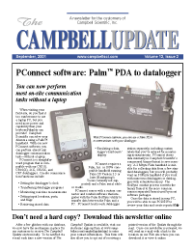Many of us can relate to the question, "Mom/Dad, can I have the keys to the car?" A simple question, but it’s not always simple to give an answer, so we say, "That depends," or "Why?" Hopefully, enough good information is gathered to generate a yes or no answer (or a yes with conditions). One hopes it is the right answer for the circumstances. A simple yes or no is logically unambiguous, yet an ultimate Boolean response may possess more meaning than the myriad possibilities in between.
Campbell Scientific invests a great deal of effort to improve the process of separating signal from noise, thus imparting an output with as much meaning as possible. The same can be said of electronic signal processing and its application to physical measurements. As today’s technology packs more computing capacity into smaller, less expensive, and low-power components, there is a trend toward more digital signal processing (DSP).
Let me define DSP as the application of numerical methods to characterize a series of related values in a summary conclusion. Campbell Scientific first implemented DSP in dataloggers in the late 1970s to compute an average wind vector. Other on-site processing such as average and standard deviation were also computed. In 1985, CSI delivered the first 21X Micrologger with Fast Fourier Transform (FFT) capability. The 21X provided a summary output that characterized ocean waves in the frequency domain from measurements gathered in the time domain. The resultant FFT and other data were transmitted from buoy to laboratory via satellite.
Our latest product advancing state-of-the-art DSP is the CR9052DC Anti-Alias Filter & FFT Spectrum Analyzer with DC Excitation for the CR9000 Measurement and Control System. Its filtering capability significantly improves the signal-to-noise ratio previously available using conventional filters. In the FFT spectrum analyzer mode, the CR9052DC can provide real-time spectra from "seamless," synchronized, anti-aliased, 50-kHz, 2048-point time-series snapshots for each of its six analog input channels. This improvement in sorting signal from noise, together with FFT output, has allowed better measurements of structural aging in mechanical joints and beams. This helps to project the useful life of a structure under test, not to mention improved measurements of mechanical resonance for modal analysis and better characterization of audio signals.
The TDR100 Time Domain Reflectometer uses DSP to construct a waveform of reflection amplitude in the time domain. The pulser circuit generates the signal that is applied to the probe at a constant rate while the sample circuit is increasingly delayed by discrete time steps. This equivalent-time sampling technique gives 12 picosecond resolution and is only possible with DSP. For soil water measurements, additional DSP functions are applied to the waveform to determine dielectric constant and signal attenuation which are directly related to water contentand bulk electrical conductivity. Simple functions that identify impedance mismatches provide information about cable length or location of cable crimps or faults. These signal processing capabilities in the comparatively small, low-power package of the TDR100, combined with a reasonable price, will lead to new applications of this exciting technology. Possibilities include measuring frequency dependent dielectric properties over a range of environmental conditions. A combination of DSP applications could be used in the same measurement to characterize properties of interest.
The CSAT3 3-D Sonic Anemometer uses DSP extensively. Measurements of wind speed are made on three axes at horizontal angles of 120 degrees with each axis vertically rotated 60 degrees. This sensor orientation minimizes turbulence artifact from the anemometer head assembly. The acoustic transit time going each way between transducers in each of the three axes is measured. Through DSP, the out and back transit times of each axis yield a wind speed along that axis. Subsequent coordinate transformation provides an output of wind speed in each of x, y, and z axes. DSP can resolve the acoustic transit times to better than one nanosecond from a relatively slow (2 MHz) sampling of the acoustic signal. This enhanced resolution allows experimenters to measure extremely small (less than one millimeter per second) changes in wind speed. The entire measurement process can be repeated at a rate up to sixty times per second. DSP technology has allowed the design of a product that sets a standard for the measurement of turbulent transport of boundary layer gases between the earth and the atmosphere.
You may be assured that your measurement work is enhanced using Campbell Scientific dataloggers and other measurement instruments to get the most meaning possible through the use of DSP technology.

